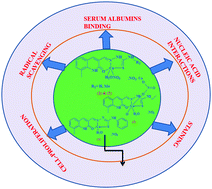Synthesis and spectral characterizations of water soluble Cu(ii) complexes containing N-heterocyclic chelates: cell-proliferation, antioxidant and nucleic acid/serum albumin interactions†
Abstract
Herein, we have reported the synthesis and characterization of a series of 8-methyl-2-oxo-1,2-dihydroquinoline-3-carboxaldehyde-4(N)-substituted thiosemicarbazones and their copper(II) complexes. The true nature of coordination between the ligands and metal ion has been confirmed by X-ray diffraction analysis. An intercalation binding mode of the complexes with nucleic acid was established through absorption and fluorescence titrations and this was further confirmed by viscosity measurements. When complexes interacted with serum albumins, the secondary structure was altered, which was confirmed by three dimensional fluorescence emission studies. Antioxidant activities of the compounds were evaluated and the complexes showed enhanced scavenging capability as compared to the ligands and standard. Further, the complexes show remarkable in vitro antitumor activity against a human breast cancer cell line (MCF-7) and are non-toxic against a normal human keratinocyte cell line (HaCaT). Acridine orange/Ethidium bromide (AO/EB) and DAPI staining assays showed that the major MCF-7 cell death route was through apoptosis. According to our obtained results, complex 4 exhibited better biological activity compared to the ligands and other complexes (1–3).



 Please wait while we load your content...
Please wait while we load your content...